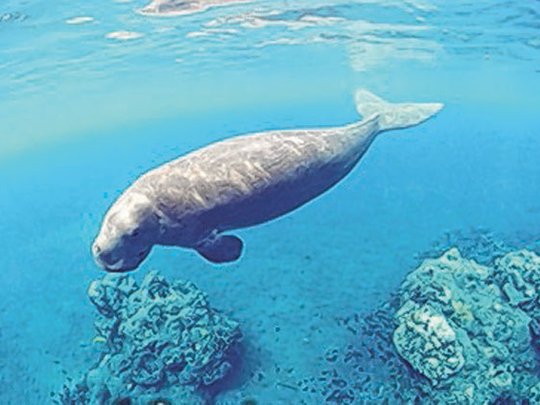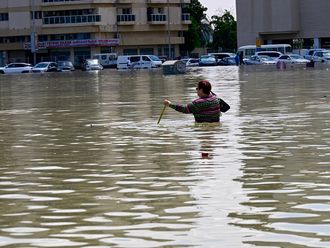
Abu Dhabi If dugongs become extinct, the impact will not be limited merely to the fact that future generations will not get to see the marine mammal — their absence will almost surely have an impact on the availability of sea fish, the staple diet of millions of people across the world.
Dugong deaths thus have a direct bearing on fish stocks and the livelihoods of millions of people and the world economy, too, experts told Gulf News recently in Abu Dhabi.
Dugongs, often known as ‘sea cows', are large marine mammals that feed almost exclusively on seagrass. They are found in warm coastal and island waters of over 40 countries in the Indo-Pacific. An estimated 3,000 dugongs live in UAE waters, according to the Environment Agency—Abu Dhabi (EAD).
Main threats
The main threats to dugongs are habitat degradation or loss, vessel strikes and hunting or incidental capture. These shy creatures not only support fish breeding but act as an ‘indicator species' which indicates the overall situation in a marine environment, experts say.
Dugongs are strict herbivores feeding almost exclusively on seagrass which serves as the nursery for juvenile fish and shrimps, as well as a habitat for a wide diversity of marine life.
"In fact, dugongs actually improve the quality and quantity of seagrass beds through their grazing activities while eating the grass," said Dr Donna Kwan, programme officer for dugongs and officer-in-charge of the Abu Dhabi office of the United Nations Environment Programme (UNEP) and the Convention on Migratory Species (CMS).
Dugongs create a healthy breeding ground for fish and shrimps, she said.
Asked if the end of dugongs would mean the end of fish stocks, Professor Helen Marsh, a technical adviser to the secretariat of UNEP/CMS office, said: "No. But it will affect the quantity [availability] of fish stock. The fish and shrimps won't be healthy without healthy seagrass beds."
Dugongs are thus economically important as they support commercially fished species — a source of huge revenue to the world economy.
About the dugongs as an ‘indicator species', two experts at the EAD said: "By observing the dugongs and turtles we can know the problems in an ecosystem as they indicate everything," said Thabit Al Abdul Salam, director of the Biodiversity Management Sector, and Himansu Das, scientist at the Biodiversity Management Marine Sector.
Dugongs are also a part of the heritage of local communities in many countries, including the UAE, Abdul Salam said.
Abu Dhabi Sri Lanka is one focus of current activities of the ‘Dugong MoU Secretariat' because there is a lack of data about local dugong populations, said Dr Donna Kwan, programme officer for dugongs and officer-in-charge of the Abu Dhabi office of the UNEP and CMS.
The Gulf of Mannar between India and Sri Lanka is home to the largest remaining dugong population in South Asia.
In Sri Lanka, the species is found from Colombo to Jaffna, particularly in the coastal waters of the Gulf of Mannar and in the Palk Bay region, where seagrass and mangrove forests abound.
Although there is limited data, dugongs were reported to be both abundant and widely distributed along coastal waters of Sri Lanka up until the late 20th century. However over the past 30 years, dugong populations have declined dramatically and sightings are now rare in most areas of Sri Lanka.
Sri Lanka is very concerned about the declining population of this species and pleased to be a part of the international programme, Sarath Wije Singhe, Sri Lanka's ambassador to the UAE, told Gulf News.
Sri Lanka is one of the less polluted countries in the world and taking great care with its industrialisation plans with due consideration for environmental conservation needs, he said.
UAE hub for international action
From its base in the UAE, the office of the United Nations Environment Programme (UNEP) and the Convention on Migratory Species (CMS) in Abu Dhabi actively promotes action for the conservation of dugongs and their seagrass habitats worldwide, working across about 40 range states to address the main threats to dugongs.
One more country recently joined this global programme.
Sri Lanka became the 21st signatory state to "the UNEP/CMS Memorandum of Understanding (MoU) on the conservation and management of dugongs and their habitats throughout their range".
The Secretariat to the ‘Dugong MoU' is funded and hosted by the Environment Agency-Abu Dhabi (EAD) on behalf of the Government of the UAE.
The secretariat works to facilitate national-level and trans-boundary actions that will lead to the conservation of dugong populations and their habitats. The conservation measures include creation of protected areas, alternative livelihood trials for fishermen, or switching to less harmful fishing techniques.
Current signatories to the UNEP/CMS Dugong MOU are: Australia, Bahrain, Comoros, Eritrea, France (including Mayotte and New Caledonia), India, Kenya, Madagascar, Mozambique, Myanmar, Palau, Papua New Guinea, Philippines, Seychelles, Solomon Islands, Sri Lanka, Thailand, United Arab Emirates, United Republic of Tanzania, Vanuatu, and Yemen.
Facts and figures
- Dugong habitats extend from the coast of east Africa across to the western Pacific islands.
- The biggest dugong populations reside in Australia and the UAE given the 140,000km of coastline globally where they may be found.
- Dugongs are slow-growing and do not reproduce frequently — even in ideal conditions, a dugong population is unlikely to increase by more than 5 per cent per year.
- The dugong is the world's only herbivorous marine mammal and the only member of the family Dugongidae.
- Dugongs enjoy a life span of up to 70 years and breed slowly. The species tends to start reproducing between 6 and 17 years with new calves being born at intervals of 2, 5 or even 7 years depending on food supply.
- Dugongs are charismatic megafauna and flagship species for coastal rural communities, having a high cultural value in many parts of the dugong range. It is also a valued source of food, medicine and even artefacts in some countries
- Dugong migrations may be local or on a regional scale.













